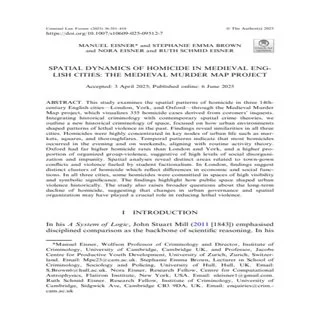By Manuel Eisner, Stephanie Emma Brown, Nora Eisner & Ruth Schmid Eisner
This study examines the spatial patterns of homicide in three 14th-century English cities—London, York, and Oxford—through the Medieval Murder Map project, which visualizes 355 homicide cases derived from coroners’ inquests. Integrating historical criminology with contemporary spatial crime theories, we outline a new historical criminology of space, focused on how urban environments shaped patterns of lethal violence in the past. Findings reveal similarities in all three cities. Homicides were highly concentrated in key nodes of urban life such as markets, squares, and thoroughfares. Temporal patterns indicate that most homicides occurred in the evening and on weekends, aligning with routine activity theory. Oxford had far higher homicide rates than London and York, and a higher proportion of organized group-violence, suggestive of high levels of social disorganization and impunity. Spatial analyses reveal distinct areas related to town-gown conflicts and violence fueled by student factionalism. In London, findings suggest distinct clusters of homicide which reflect differences in economic and social functions. In all three cities, some homicides were committed in spaces of high visibility and symbolic significance. The findings highlight how public space shaped urban violence historically. The study also raises broader questions about the long-term decline of homicide, suggesting that changes in urban governance and spatial organization may have played a crucial role in reducing lethal violence.







